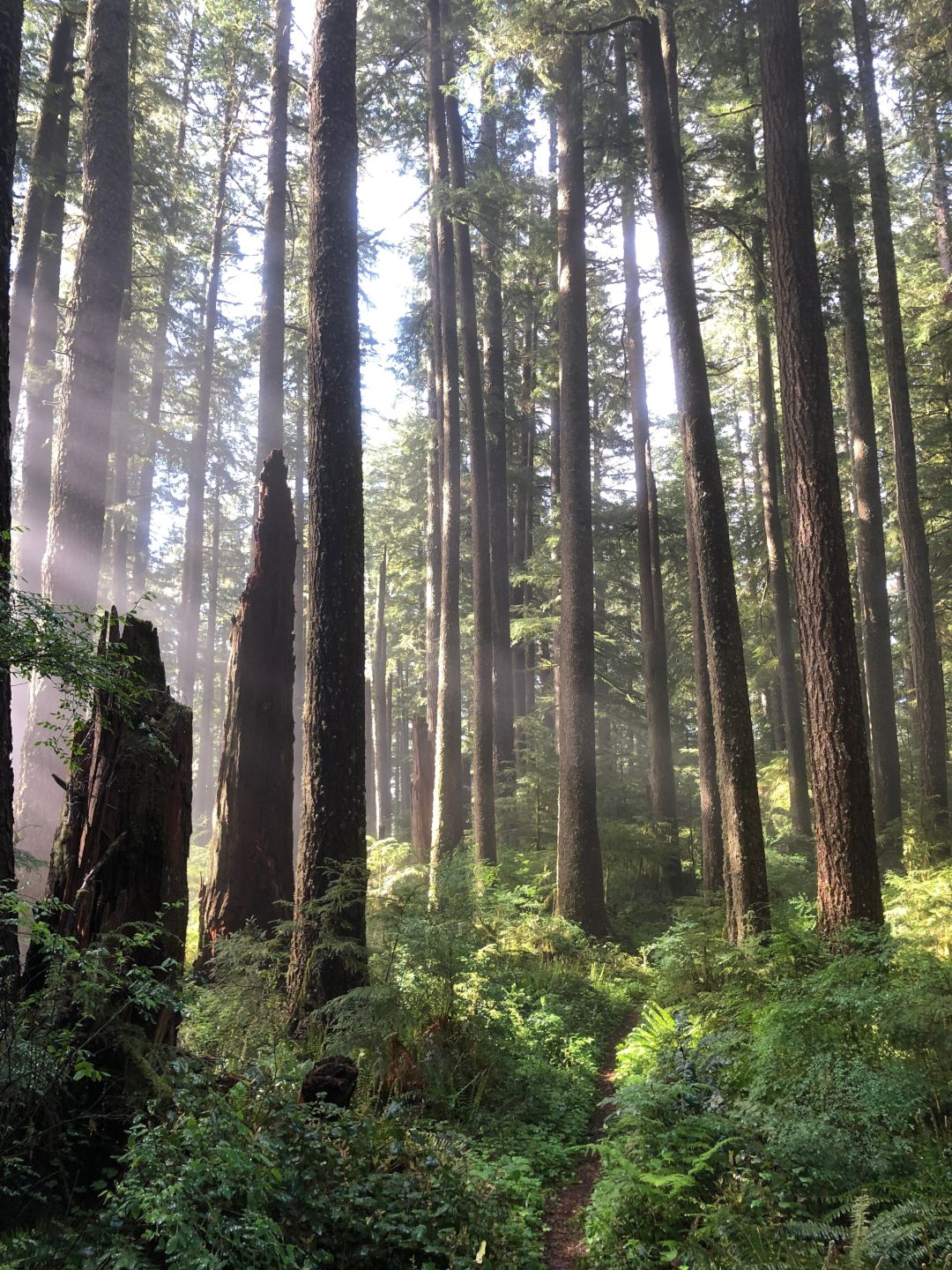
by DGR News Service | Jun 14, 2021 | Biodiversity & Habitat Destruction, Direct Action, Education, Movement Building & Support, Obstruction & Occupation
This article originally appeared in The Conversation.
By David Tindall, Professor of Sociology, University of British Columbia
The RCMP has recently been arresting protesters who had set up blockades to prevent the logging of old-growth forests on Vancouver Island. Environmentalists say the Fairy Creek watershed, near Port Renfrew, is the last old-growth area left on southern Vancouver Island, outside of protected areas.
The contested forested areas lie close to the internationally known West Coast Trail, and within the unceded traditional territory of several First Nations, including Pacheedaht and Ditidaht.
Some of the trees are more than 1,000 years old and are part of rare ecosystems that some independent estimates suggest make up less than one per cent of the remaining forest in B.C. Close to 25 per cent of the world’s remaining temperate rainforest is in B.C., mainly along the coasts.
The demonstrators established the first blockade in August 2020 along the logging roads into the Fairy Creek watershed, where Teal-Jones has a “tree farm licence” to harvest timber and manage forest resources. Now dozens of people, including some First Nations youth, have been arrested for violating a B.C. Supreme Court order that restricts protesters from blockading the logging roads.
This dispute resembles the protests over Clayoquot Sound (also on the west coast of Vancouver Island). Dubbed the “War in the Woods,” more than 850 people were arrested in 1993 for blockading logging roads. That protest, sparked by a decision to allow logging in the area, was the largest act of civil disobedience in Canadian history and a seminal event in the history of the environmental movement.
As a researcher of social movement and environmental issues, I have been surveying the general public and environmental activists about their attitudes and behaviours for about three decades. I am particularly interested in environmental conflicts and the factors (such as social networks) that explain why people get involved incollective actions to protect the environment or to protest against such actions (pro-industry protesters).
This research can shed light on current and future conflicts. People who support the goals and values of a movement can be drawn into it, what social movement scholars call “the mobilization potential.” However, involvement is often contingent upon other factors, such as social ties to other participants.
‘War in the Woods’ redux?
The connection between Fairy Creek and Clayoquot Sound was highlighted when Tzeporah Berman — a high-profile environmentalist and a leader of the Clayoquot protests — was arrested at a road leading into the Fairy Creek watershed in May.
Berman, who is also the director of the environmental organization Stand.earth, co-ordinated the blockade in Clayoquot Sound 27 years ago. She was arrested then too, although the long list of charges was eventually dismissed on constitutional grounds. No large-scale industrial logging occurred in Clayoquot in the aftermath of the protests.
More recently, anti-logging protests focused on the old-growth forest in the Great Bear Rainforest. Environmentalists, the forestry sector, First Nations and the B.C. government eventually worked together to establish a 2016 agreement to protect the Great Bear Rainforest.
Since then, various environmental groups have continued to campaign to protect old-growth forests. But these efforts have often been overshadowed by protests against oil and gas pipelines and overarching activism about climate change.
Understanding beliefs about old-growth forests
An old-growth forest is one that has not been disturbed by large-scale human activities, such as industrial logging. In B.C., these forests have been growing since the last ice age, about 10,000 years.
They include gigantic trees such as red and yellow cedars, Sikta spruce, hemlock and Douglas firs, which are sometimes as tall as a football field or soccer pitch is long. One thousand-year-old trees may be the most iconic features of coastal old-growth forests, but the forests also promote biodiversity by providing habitat to numerous wildlife species, many of which do not thrive outside of old-growth forests.
Logging has contributed to the dramatic decline of B.C.‘s old-growth forests. One independent study suggested that the majority of B.C.’s productive old-growth forests have been logged, and there are plans to log the majority of what remains.
In a 2007 survey, my group found that 75 per cent of the general public completely or mostly agreed that “clearcut logging should not be allowed in old-growth forests.” So did 93 per cent of environmentalists.
We also asked about the statement: “Some forested areas should be set aside in order to protect endangered and threatened species (e.g., the spotted owl, the spirit bear).” Here, 94.2 per cent of the general public and 98 per cent of environmentalists completely or mostly agreed.
In 2005, >I members and supporters of the Friends of Clayoquot Sound, one of the main organizations involved in the protests. That study asked people about various types of civil disobedience, and found that 90 per cent of environmentalists believed that blockading logging roads greatly or somewhat helped the cause, and 84 per cent believed that occupying trees greatly or somewhat helped the cause.
It is difficult to assess the outcomes of social movements, but civil disobedience has been successful in the past. Media attention, changing public opinion and disruption can put pressure on governments to change course.
Growing protests
Protesters have been blocking access to logging roads and positioning themselves high in trees to disrupt harvesting operations in the Fairy Creek area, drawing the attention of the media and the public and putting pressure on government. The RCMP responded slowly at first, but recently began to enforce the court injunction and have restricted access to the protest sites.
While the protest has been going on since late last summer, its activities have recently heated up. Environmentalists want the government to adopt the recommendations from a new advisory report on old-growth forests. It seems likely that the protest will grow.
A large number of people see civil disobedience as being effective and are willing to do it. Once the B.C. government eases COVID-related restrictions, more people will likely become involved in protests. Pleasant weather and flexible summer schedules may encourage others to join. Satellite protests regarding the threat to old-growth forests will also continue in urban centres.
The RCMP says it has arrested more than 100 people already, and 75 seniors from the Victoria area have joined the protest at Fairy Creek. This may just be the beginning of another “War in the Woods.”
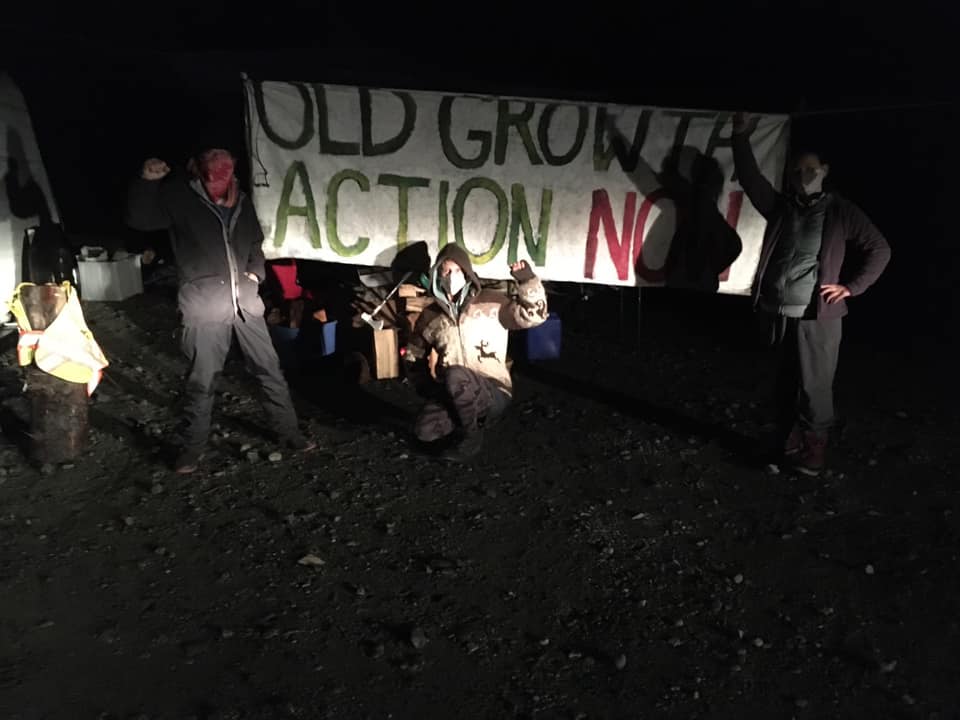
by DGR News Service | Dec 18, 2020 | Obstruction & Occupation
This is an update regarding the chronology of events for the Old Growth Blockade which strives to protect the last old-growth temperate rainforests on Vancouver island, currently facing near-total eradication by the British Columbia government and logging companies.
The Rainforest Flying Squad launches the Bugaboo Creek blockade to prevent road building into the last ancient forests of the watershed.
- Friday, December 11th, a group of Forest Protectors with the Rainforest Flying Squad have moved the Bugaboo Blockade south to block a road adjacent to the world famous Avatar Grove, to prevent road building crews from continued road building into the south side of the Bugaboo’s Ancient Rainforest in Camper Creek on Pacheedaht Territory.
- This comes on the heels of the creation of the first Bugaboo Blockade on December 7, when the Rainforest Flying Squad prevented logging in high elevation old growth western red and yellow cedar forests. Shortly after the creation of that blockade the road building contractor moved their equipment from the north side of the Bugaboo’s Ancient Forest to the south side where another road has been approved into a magnificent stand of Ancient Trees. “The message is simple,” said one of the Squad, “we want no more logging, no more road building into the last of our ancient forests.” After following vehicles moved from the north side of the Bugaboo, and discovering the contractor intended to begin road building on the south side of the rainforest the squad decided to move camp, continuing to monitor the north side as they prevent road building into the southern part of the forest.

- In the meantime another group of Protectors have now mobilized to protect valley bottom old growth forest south of Eden Grove in the Edinburgh Mountain Ancient forest. They have set up a blockade on the bridge leading to Big Lonely Doug, the iconic Douglas Fir tree that stands in an old growth clear-cut on Edinburgh Mountain. This is in response to an application submitted by Teal Jones that would allow for the construction of a logging road into valley bottom old growth forest south of Eden Grove.
- The new Edinburgh Blockade will remain in place as long as it takes to prevent further fragmentation of the Edinburgh Mountain Ancient Forest. The barricades are holding strong at Fairy Creek and meanwhile the Bugaboo Squad will continue to block access and monitor both intrusions into the rainforest until snow pack eliminates the risk of road building into the Bugaboo Ancient Forest. The protesters expect road building crews to remove their equipment in the next few days, they say if the contractors move the equipment back to the north side of the old growth forest, they will be back and blockade there again.
- The blockaders on both blockades are demanding;
- That logging contractor Stone Pacific give up road building into old growth forests in TFL 46 and move their machinery to work on road networks targeting second growth.
- That the Ministry of Forests decline the Teal Jones groups application for new road building on Edinburgh Mountain.
- That the provincial government and Premier John Horgan immediately implement the recommendations of the OGSR and end all old growth logging across British Columbia
- The government immediately shift all forestry operations to sustainable management of silvicultural land-base as a source of long-term employment in local and First Nations communities.
Until these demands are met, the Rainforest Flying Squad will continue to disrupt the timber industry in its attempts to log the last of our Ancient Temperate Rainforests.
#rainforestflyingsquad#savefairycreek
Learn more about the Old Growth Blockade. You can make a donation via GoFundMe. You can also check this other articles regarding the blockade.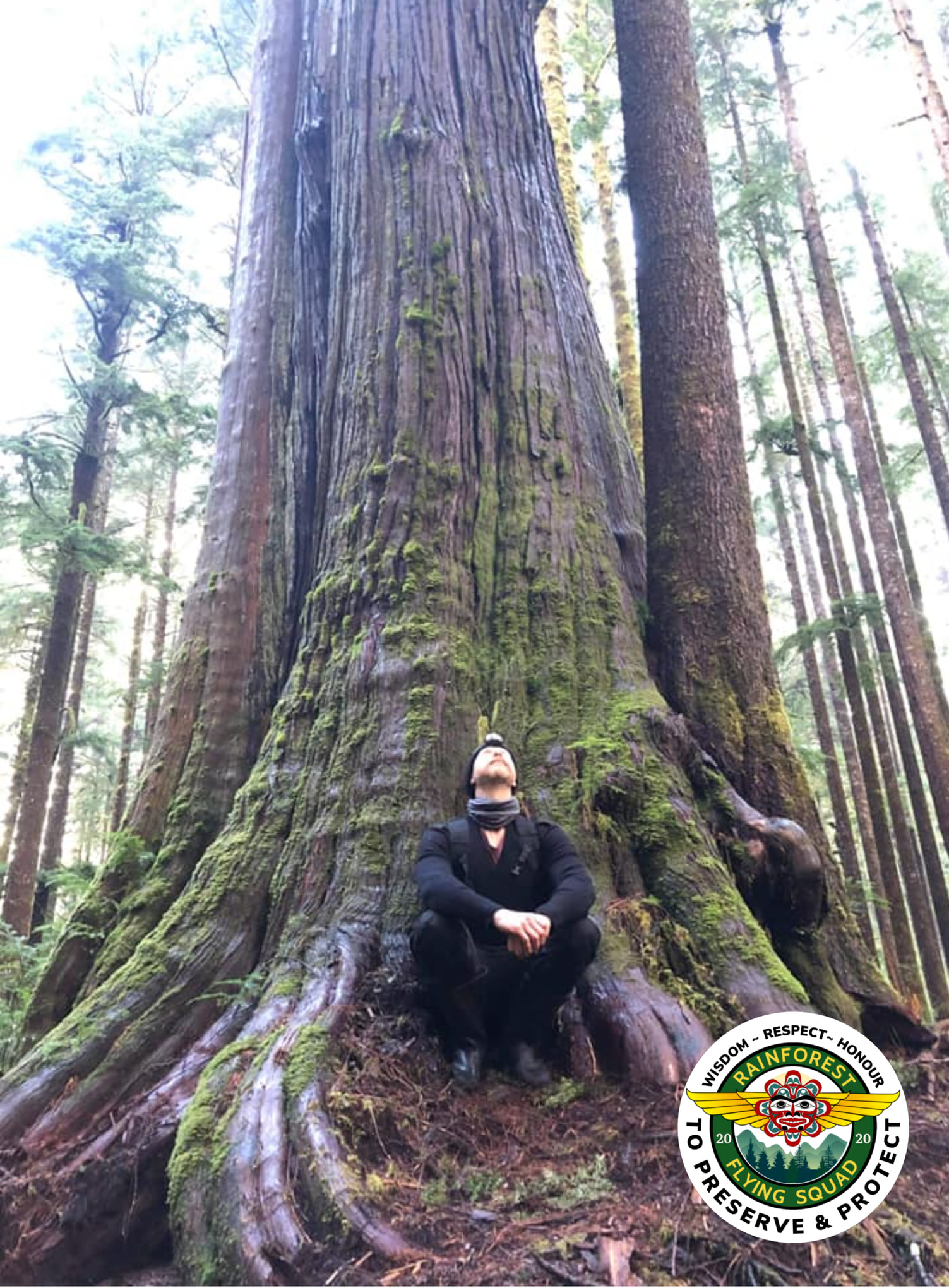
![[Old Growth Blockade] Old-Growth Blockade Enters Fourth Month](https://dgrnewsservice.org/wp-content/uploads/sites/18/2020/11/fairycreek.jpg)
by DGR News Service | Nov 12, 2020 | Obstruction & Occupation
Fairy Creek Blockade: defending old growth forests on unceded Pacheedaht territory
by Reuben Garbanzo, on Lekwungen territory
Joshua Wright, is a seventeen year old film-maker from Olympia, Washington with an irrepressible passion for protecting the last remaining old-growth temperate rainforests; and has handy access to a state-of-the-art digital mapping program that allows him to track and monitor industrial logging activities in near-real time. In early August, this year, he gave heads up to Vancouver island grassroots forest activists to a road-building crew subcontracted to Surrey-based tenure-holder of TFL 46, Teal Jones, cresting the ridge into the old-growth Yellow Cedar headwaters of Ada’itsx/ Fairy Creek watershed, the last unlogged tributary of the San Juan River system, unceded Pacheedaht territory, near Port Renfrew.
Forest firefighter Will O’Connell surveyed the road-building operation with spell-binding drone footage that captured earth-moving machinery operating on dangerously steep terrain pushing into a watershed never before logged, with no current cutblocks approved, but nonetheless heightening the risk of logging plan approvals, once the investment of road infrastructure had been established. This bold expose of a logging road incursion into one of the last roadless places on southern Vancouver island rapidly spread on social media and in the midst of a pandemic, galvanized forest defenders into non-violent direct action.
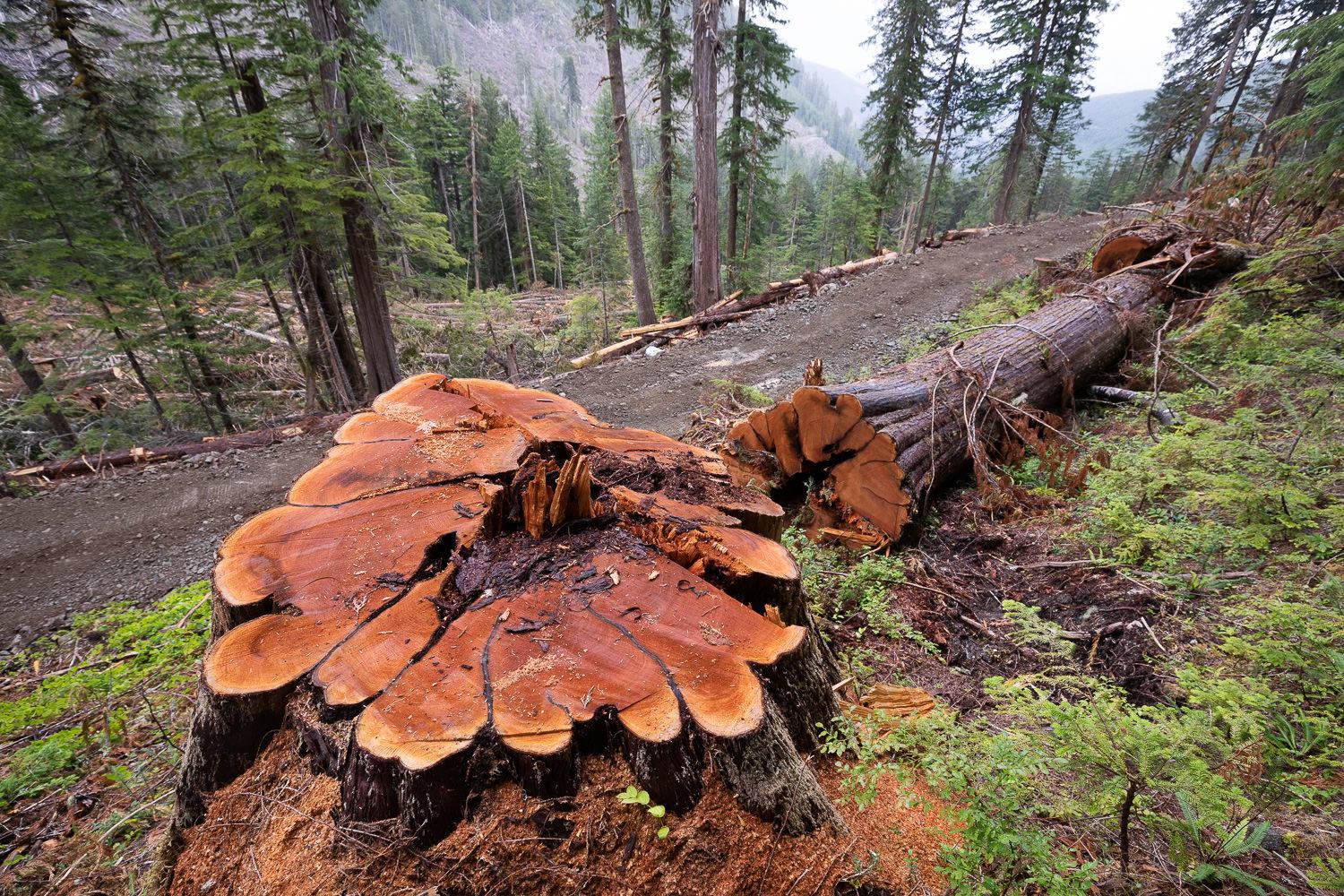
On Sunday, August 9th, twenty ancient forest activists from all over the south island, including the nearby communities of Port Renfrew and Cowichan valley, gathered at Lizard Lake and decided to set up a road blockade above the clouds 1000 metres up a treacherous logging road on a steep ridge overlooking the Gordon river valley, on the western flank of Fairy creek, where road-building into the Fairy, was slated the next work day. Tents were set up under the giant bucket of a gargantuan excavator and a 10′ diameter cedar log round from an ancient tree felled in the Klanawa Valley, propped vertically on a plywood frame, was installed as a barricade centrepiece across the road. When the Stone Pacific road crew arrived in darkness at 5 am the next morning they were politely confronted by a dozen people putting on the morning coffee around a small fire on the road end, with the intention of protecting Fairy Creek from road incursion.
Two weeks later another blockade was set up to protect the watershed on its eastern flank and to stop clearcut logging in an area of contiguous ancient forest that is part of the 5100 acre Fairy Creek rainforest, much of which is already under Old-Growth Management and Wildlife Habitat Area designation.
Pop-up blockades disrupting business as usual in other remnant old-growth forest locales have also sent a message to government and industry that in a down-spiraling climate and biodiversity crisis, disruption to the status quo is to be expected until the government takes decisive action to protect what is left of these globally significant and irreplaceable forests. The objectives/demands of all these blockade actions is to protect the last 1-3% of low-elevation old-growth rainforests left standing on so-called Vancouver island.
The Ada’itsx/Fairy Creek blockades are now entering their fourth month with no logging or road-building behind the barricades and no injunctions or arrests. This blockade, now the longest land-based direct action campaign on this island in over two decades has evolved quickly into a decentralized grassroots direct action movement under the banner of oldgrowthblockade, aimed to stem the tide of the colossal destruction of the shocking equivalent of 32 soccer fields of old-growth forests per day on the island alone.
Winterized infrastructure has been built at the main Fairy Creek base Camp, 7 kilometres off the the Pacific Marine Rd. including wood-heated Elder and Indigenous Warriors’ tents, bear-proof kitchen arbour, tool shed and hot water shower and change room. Dozens of volunteers communicating via several online platforms have provided coordination and mobilized material support to the frontlines which have been steadily maintained by a gritty, dedicated crew of core forest defenders, young and not so young, mostly women, who provide daily logistical coordination, elder care, leadership, hosting and reconnaissance on the ground.
This settler-Indigenous blockade has been blessed with the support and wise leadership of Pacheedaht elder Bill Jones who has asked that the entire valley, part of his childhood stomping ground, be dedicated as an Indigenous Protected Area in honour of the victims of the smallpox epidemic. Pacheedaht Chief and council have not responded for or against the blockade. The area is in the electoral riding of Premier John Horgan who has himself yet to respond to the demands of the blockade to protect Fairy Creek rainforest and all remaining old-growth temperate rainforests on the island.
On September 29th, the blockade received a strong statement of support from the Union of British Columbia Chiefs (UBCIC) who issued a breakthrough resolution calling on the Province to implement all 14 recommendations of their Old-Growth Strategy Review report and for the immediate protection of key old-growth forest hotpsots including Fairy Creek. Most significantly, their resolution called for government to assume responsibility in invesment in supporting First Nations to break free from the economic dependency on the old-growth forest destruction of their land-base, a major policy piece in the transition away from the destructive legacy of old-growth logging, once and for all.
To join the blockades:
https://oldgrowthblockade.com
To donate:
https://www.gofundme.com/f/bc-old-growth-blockade
Fairy Creek Blockade Chronology of Events:
August 1st : Discovery of Stone Pacific ( subcontracting to Teal Jones) road construction cresting the Ridge into the unlogged Fairy Creek headwaters
August 9: Grassroots activists from across Vancouver island meet at Lizard Lake and decide to erect an emergency logging road blockade at the end of Reid mainline, on a high ridge on the western side of Fairy Creek headwater, to prevent cutting, bulldozing and blasting activity into Fairy Creek the very next day. Notice is sent to Pacheedhat Chief and Council and Elder Bill Jones of setter-activist intentions to block road-building operations on their unceded territory.
August 10: Ridge camp blockade turns away Stone Pacific road and falling crews. Call out to request people to attend camp to defend against logging road construction into the last unlogged watershed in the San Juan River system.
August 17th: 2nd blockade at River Camp is established at another road access point into Fairy Creek along Granite mainline in the Renfrew Creek watershed, on the east side of Fairy Creek.
August 24th: a temporary, pop-up blockade is set up on Braden Mainline aimed at halting road-building and logging of old-growth forests on Edinburgh mountain, across from Fairy Creek in the San Juan river basin.
August 31st: Ridge camp blockade is moved 7kms down the road to a new blockade location aimed at halting road-construction into Fairy Creek and logging of contiguous old-growth forest adjacent to the Fairy Creek watershed.
September 4: Pacheedaht elder Bill Jones releases an official letter of invitation to Indigenous and non-Indigenous forest defenders to unite on the territory to defend the old-growth rainforests on his ancestral lands. An Elder’s tent is built at River Camp, where the elder has been staying overnight.
September 6: A caravan of Indigenous youth and elders, from many territories visit the blockades to further advise on appropriate respect protocols for forest defenders taking action on the land. 📷
September 22: The blockade camp on Reid main is moved back to its original position at the top of the Ridge at the end of Reid main. More Pacheedaht community members visit the blockades.
October 3: Northview Timber pulls road-building machinery off the mountain, abandoning plans to push roads through into Fairy Creek, past Ridge Camp, until after winter. Ridge camp remains for monitoring. Winterization of River camp continues, including bear-proof communal kitchen shelter, wood-heated communal tents, tool shed and a hot water shower.
October 22: An exploratory trail is cut from the Ridge camp along the Ridge to a lookout point above Ada’itsx/Fairy Creek with a group of Indigenous youth.
October 25: A sacred fire is lit at River Camp by Indigenous elders, youth and matriarchs, for prayer and ceremony, supporting the blockade, the forest and forest protectors.
November 9: Pop-up blockade is established at Grierson main to protect rare valley bottom ancient rainforest from road-building into Camper Creek headwaters.

by DGR News Service | Sep 28, 2020 | Direct Action, Obstruction & Occupation, The Solution: Resistance
Blockade Musings on Patcheedaht Unceded Territory
By Esther Muirhead
Winding my way from Lake Cowichan to Port Renfrew, the ravages of continuous clearcuts on steeply sloped mountains, magnified the sun’s rays bouncing off rocky mirrors of ravaged lands, like water hitting a hot frying pan. Driving up the mountain to (Renfrew) River Blockade, stopping road-building on the east side of Fairy Creek, the ominous logging roads carved into mountains and the large machinery scattered about, I wondered what planet I was on. Once at the blockade, and walking into a replica of a 200 million year old rainforest ecosystem, I took a deep breath and wept. Did you know that 200 million years ago, coniferous forests almost went extinct as a result of the evolutionary advancement of flowering trees that came to dominate the earth? The conifers retreated to the margins of the planet where a small number of species managed to maintain a foothold by adapting to extremely harsh conditions. Along the northwest coast of “Canada” is the only region where the conifers retain their former glory, revolving in and out of 10 thousand year cycles to create globally rare ecosystems. They are able to grow throughout the long winters and since they use water more efficiently than flowering plants they also thrive during the dry summer months. The result is a living organism so rich and so productive that temperate forest biomass is easily four times as great as that of any area in the tropics. Within the crown of a single conifer, is found as many as 1500 animal and plant species.
The ecological and spiritual value of old growth forests can never be reconciled with the resource extraction world view.
The intrinsic value of ancient forests has no place in the calculus of forest planning, which has, since its’ inception, allowed for the eventual total eradication of ancient forests. Forestry as traditionally practiced in the BC is less a science than an ideology; a set of ideas reflecting the aspirations of a closed group of professionals with a vested interest in validating its very short term, industrial practices. Old growth is “harvested” though it was never planted by humans, ancient forests are deemed “decadent” and “over mature.” In 1998, independent scientists concluded that BC logging of old growth had driven 142 salmon stocks to extinction and left 624 others on the brink of extinction. We live at the end of the clearcut; if we do nothing they will be lost within our lifetime.
Attempting to walk through the forest with my two walking poles, I would continuously fall through nurse logs into spongey damp ferns and moss up to my chest. Standing in the presence of a 3,000 year old cedar tree, knowing that she is taking care of countless younger trees, holding up the banks of the creek, pouring out oxygen in all directions, my mind stood still. These last stands reveal the intelligence of evolution and the source of ancient mythologies.
The highlight of the blockade were the frequent visits from Bill Jones, a Pateechadht elder, whose traditional homelands include the Fairy Creek watershed.
Bill described himself as the only wild Indian left in his village. I heard him saying that he wished that the federal government would cancel all band funding so that people would be forced to return to the land. He figured that most people would die but they are already dying anyway, due to poverty, health problems, drug overdoses, suicide, and domestic violence. Bill was always overflowing with patience, joy, warmth and compassion. His support is allowing us to remain confident in our efforts to save this sacred place.
One of the major issues that has arisen is clarifying how to gain consent from the Patcheedadht First Nation in support of us being on their land. We were not surprised that the Band Council did not reply to the letter sent in early August informing them of the blockade plan. I hear that poverty is widespread and with fish and hunting stocks very low, so jobs running a local mill, outfitted by Teal-Jones especially for old-growth timber, is appealing to many. The village is comprised of maybe 60 people, most youth leaving for the city and no hereditary chieftains have survived. Bill Jones was already known to us from the Walbran/Carmanah campaign and he gave us his blessing the moment he heard about the Fairy Creek blockade.
You can support the blockade by reinforcing our demand for legally binding legislation to permanently end the logging of BC’s last remaining 1% old growth forests.
Last week, the NDP came out saying they will defer logging in a few old-growth forests, for 2 years. Fairy Creek was not included in any of the deferments. This is Vicky Husband’s response, quoted in Focus Victoria; “The government’s response to the Gorley-Merkel (Old-Growth Review Panel) is a shoddy piece of spin-doctoring in advance of an election. It is duplicitous in intent, short on facts and intentionally misleading.”
We are seeking donations of thousands of dollars to hire a forest ecologist, archaeologist and biologists to argue that Fairy Creek must be protected from Teal-Jones’ chopping block.
Please contribute by sending an e-transfer donation to: rain4estflyingsquad@gmail.com
For more information contact <ejmuirhead4@gmail.com>.
For more information on the situation at Fairy Creek,
Featured image: Coniferous forest in Canada. By World Bank Photo Collection via Flickr. Creative Commons 2.0
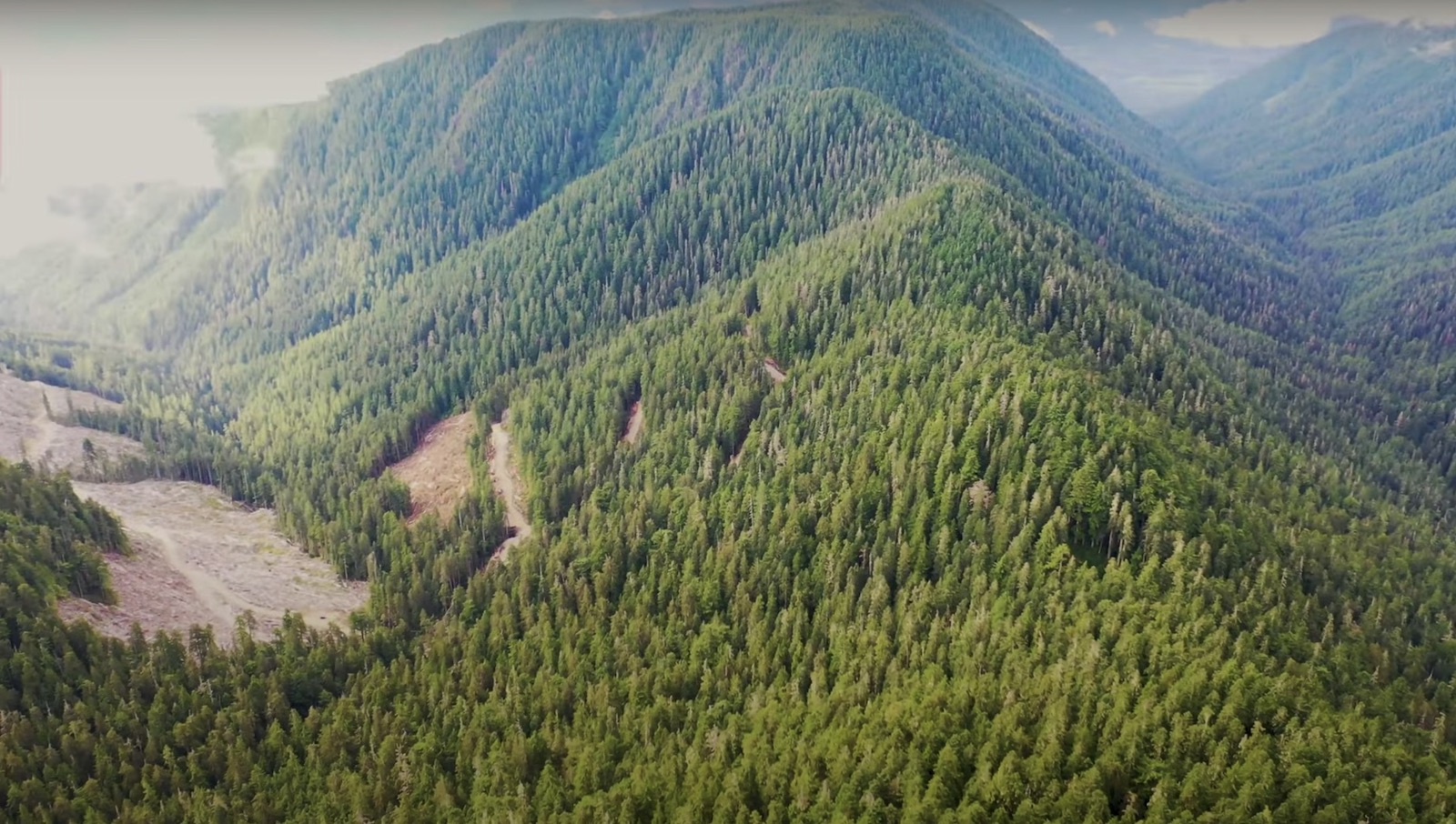
by DGR News Service | Sep 16, 2020 | Biodiversity & Habitat Destruction, Obstruction & Occupation
An ongoing blockade to protect old-growth forests in western Canada has now lasted more than a month, but blockaders hopes that a government report would help protect the Fairy Creek Valley have been dashed.
Forest Defenders Hold the Barricades as the BC Government Fails to Defer Road Building and Logging into the Fairy Creek Rainforest
September 14, 2020
Featured image: Road building in the old growth forests of the Renfrew Creek Watershed, part of the greater Fairy Creek Rainforest. (Photo Credit: Ken Dawson)
The forest defenders blocking road and logging access to Fairy Creek are devastated that it was not included in the government’s announcement of deferrals of forest areas of the province. The Old Growth Strategic Review recommended: “immediate response to ecosystems at very high risk,” through deferrals. That would emphatically include Fairy Creek, which lies within unceded Pacheedaht Territory. Instead the government included Clayoquot Sound that the review did not recommend deferring.
Roads accessing Fairy Creek were going forward and poised to enter the watershed when stopped. This constitutes imminent threat. Other old growth forests in southern Vancouver Island, either under immediate threat or where active logging is taking place are: the Caycuse where there is active logging and roading; Edinburgh Mountain and the Central Walbran, both with multiple new approved cut blocks and road proposals; and the Nahmint Valley, where BC Timber Sales was censured by an internal review for violating its own legal requirements.
All of these areas deserve, and must receive, permanent protection from logging.
Among other areas of concern on Vancouver Island are the West Kauwinch River, and the Zeballos Lake watersheds, both similarly intact watersheds at imminent risk from new logging and road building. Fairy Creek has spectacular yellow cedar stands, a highly endangered and underrepresented species in BC’s forest inventory. The review calls for further protection of these species, yet the headwaters of Fairy Creek, and several adjacent old growth forests remain slated to be logged. Surely, the last intact watershed in the immense San Juan River drainage deserves a permanently protected designation.
We demand that the government immediately defer Fairy Creek and the other contiguous old growth forests from further incursions and permanently protect them from logging.
Until that happens, the blockades of the accesses into Fairy Creek will remain in place as support grows for protection following the OGSR report that highlights gross mismanagement, misinformation and collusion between government and the forest industry, where the public interest and that of the standing forests seldom enters their calculations.
Contacts:
For more information on the situation at Fairy Creek,





![[Old Growth Blockade] Old-Growth Blockade Enters Fourth Month](https://dgrnewsservice.org/wp-content/uploads/sites/18/2020/11/fairycreek.jpg)


